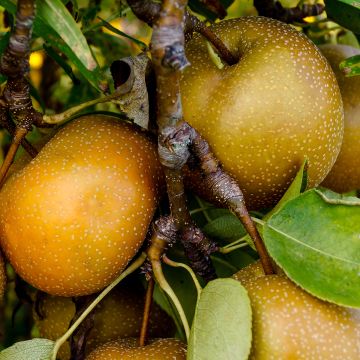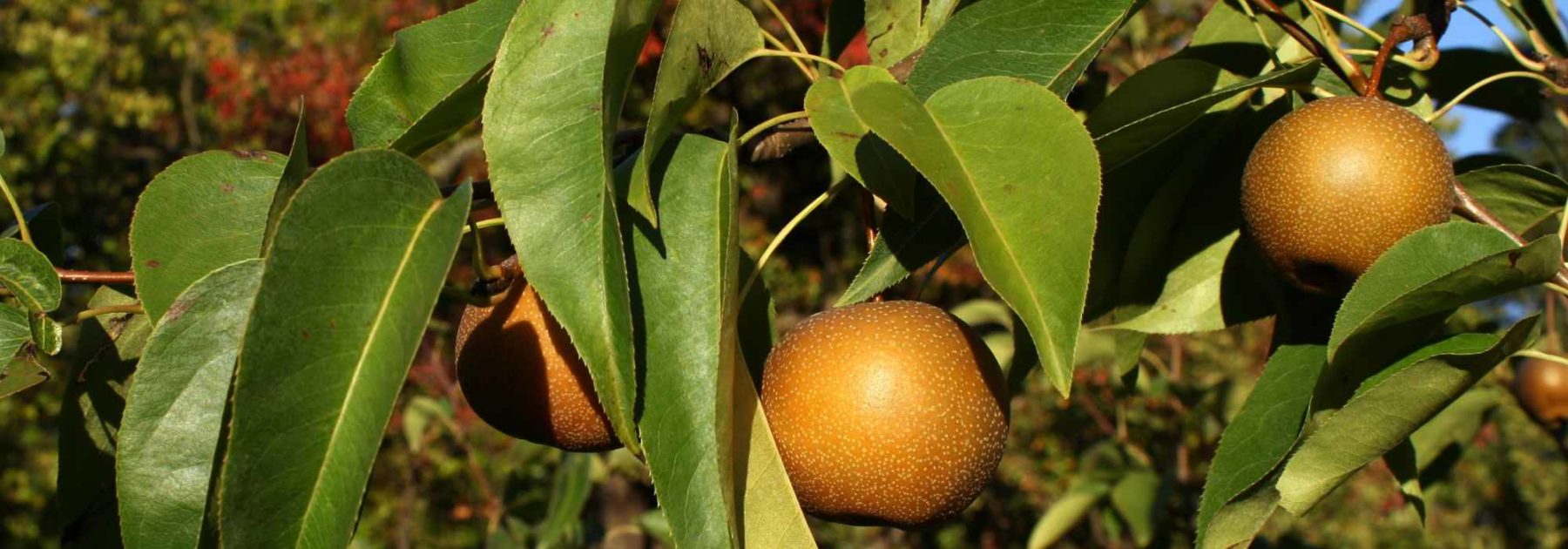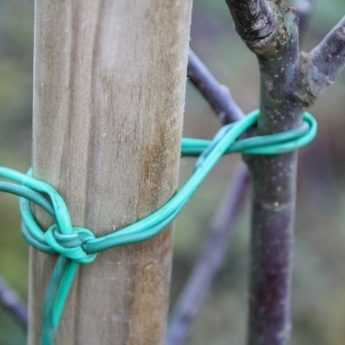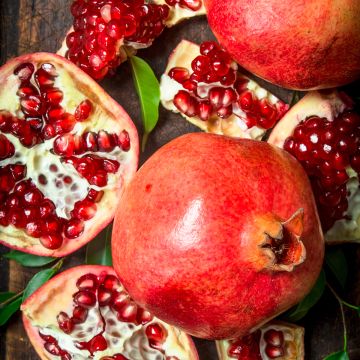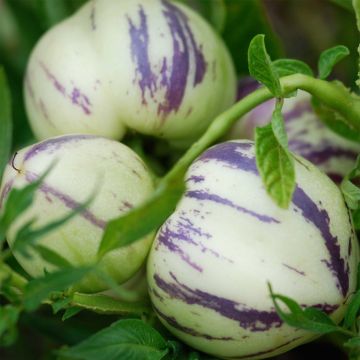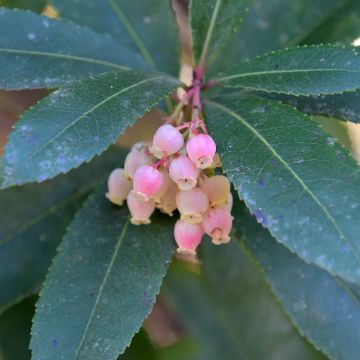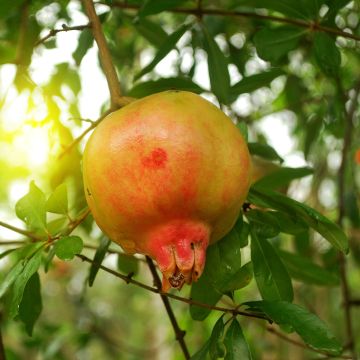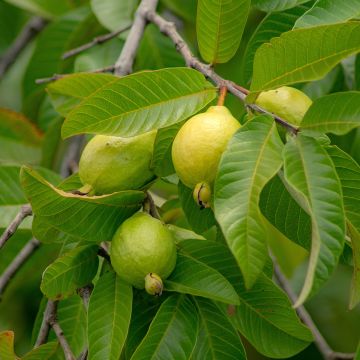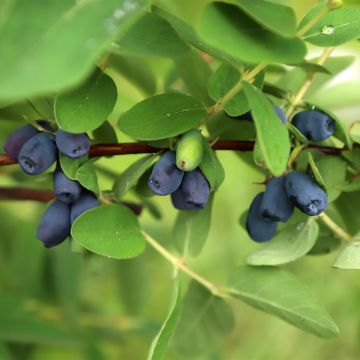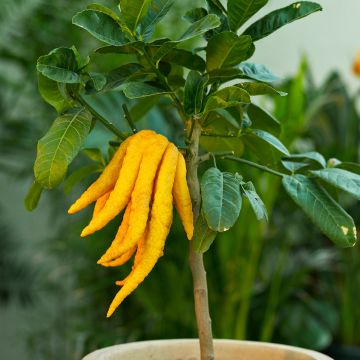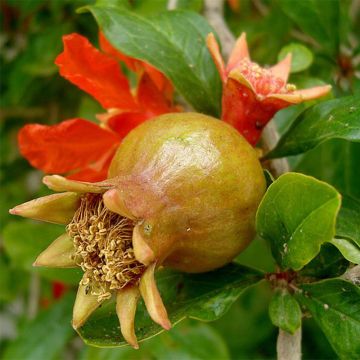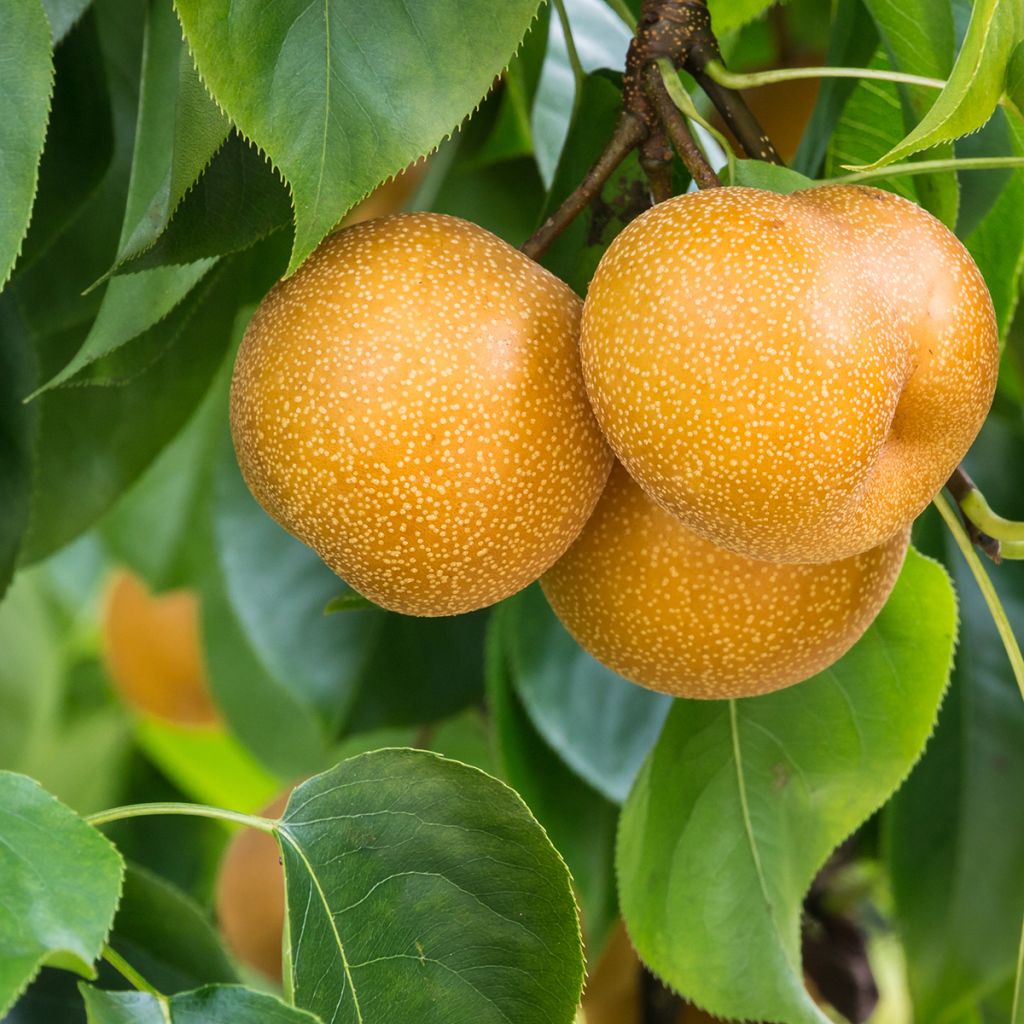

Pyrus pyrifolia Ichiban - Pyrus pyrifolia Kosui - Asian Pear
Pyrus pyrifolia Ichiban - Pyrus pyrifolia Kosui - Asian Pear
Pyrus pyrifolia Ichiban
Asian pear, Japanese pear, Korean pear, Nashi pear, Sand pear
Why not try an alternative variety in stock?
View all →This plant carries a 6 months recovery warranty
More information
We guarantee the quality of our plants for a full growing cycle, and will replace at our expense any plant that fails to recover under normal climatic and planting conditions.
Description
Asian Pear 'Ichiban', in Latin Pyrus pyrifolia ‘Ichiban’ is a small tree with a graceful silhouette, which fits well in a garden with limited space or trained against a wall in the sun. It is hardy ( to -15°C) and it produces medium-sized fruits, rounded like an apple. Its skin is slightly rough, quite thin, golden bronze, taking on bronze-brownish hues when ripe and marked with white dots all over its surface. The white flesh is surprising and pleasant in the mouth, fine, crunchy, sweet, very juicy, and sometimes granular in its centre. The Asian Pear can be eaten raw or cooked. The harvest takes place from late June to late July. The fruits can be eaten as soon as they are picked, as they ripen, and can be stored for a few weeks in a cool place. This Japanese pear tree prefers a sunny exposure, in well-draining, moist, deep, rich, and non-chalky soil.
The Nashi, Pyrus pyrifolia or serotina, more commonly known as apple-pear, Japanese pear, Asian pear, or sand pear, is a fruit tree belonging to the Rosaceae family, like the Pear tree or the Apple tree. It is native to China and Japan, where it grows up to medium mountain altitudes. It has beed cultivated for a long time in Asia. "Nashi" is a Japanese word that can be translated as "pear" and refers to both the shrub and the fruit. Although the Nashi is not a cross between an apple tree and a pear tree, its fruits are sometimes called "apple-pear" because they resemble apples while having the texture of pears.
Nashi 'Ichiban' is a hybrid, a very productive variety, with rapid, abundant and regular fruiting. It forms a small tree with a fairly upright framework that can reach 3 to 4 metres high, producing many slightly arched branches, with a spreading habit. Its habit is well suited for standard forms (on a stem) or low forms (in a goblet shape) or trained forms (fan-trained). Its deciduous foliage is composed of large lanceolate, 7 to 10 cm long, alternate, dark green and shiny leaves which take on yellow-orange-red autumnal hues before falling. Flowering occurs in April, which usually protects it from frost. The single, white, 2 to 3 cm diameter flowers grouped in umbels, are nectar-rich. They can be destroyed by frost from -2 to -3°C. It is a fairly hardy tree that can withstand temperatures around -15°C, and it is suitable for cultivation in all regions, including low altitudes. This Japanese pear tree is self-sterile or self-incompatible, the flowers cannot fertilise themselves. That is why the presence of other varieties of pear trees nearby, whose flowering occurs at the same time, is necessary for cross-pollination. The varieties Nashi Hosui, Nashi Shinseiki, Nashi 'Kosui' or William's are good pollinators for Nashi 'Ichiban'.
The harvest, depending on the region and exposure, begins around late June-early July. The fruits can be eaten as soon as they are picked, as they ripen. The nashi is ripe when the skin is smooth and taut, and the fruit is soft around the stalk. Nashi can be eaten raw or cooked. When eaten raw, it is pleasant to bite into the skin, which sets it apart from other fruits. It is used for jams, compotes, pastries (pies, crumbles...), and desserts where it pairs well with chocolate or rhubarb or with panna cotta, not to mention fruit salads. It is important to pick the fruits only when they are ripe, as they do not ripen further after harvest.
The nashi is rich in water, refreshing and thirst-quenching. It is very fleshy, making it satisfying. It is low in calories and rich in potassium and magnesium, with a significant copper content. Its content of vitamins C and K, antioxidants, and fibre makes the Japanese pear a healthy choice. It is invigorating, energising, and rehydrating. The fruits can be stored for a few weeks to 2 months after harvest in a cool, clean place, protected from light at a temperature around 8 to 10°C or in a cold room, sealed off from outside air at a temperature of 1 to 3°C.
In the Nashi category, Nashi 'Ichiban' is a very early variety, of medium vigour, but very productive. To obtain good quality fruits, thin to reduce the number of fruits on the tree. Pruning for air circulation, by removing some branches in the centre of the tree, will provide light and give the fruits a beautiful colouration. This will also limit the occurrence of diseases. It is appreciated for its fruit qualities, decorative due to the elegance of its habit and surprising due to the autumnal colouration of its foliage, making it a real asset in the garden.
Plant habit
Fruit
Flowering
Foliage
Botanical data
Pyrus
pyrifolia
Ichiban
Rosaceae
Asian pear, Japanese pear, Korean pear, Nashi pear, Sand pear
Cultivar or hybrid
Other Asian Pear trees
View all →Planting and care
Your 'Ichiban' Nashi needs warmth so plant it sheltered from prevailing winds, especially further north, and preferably in full sun. Nashi thrives in moist, rich soils without stagnant moisture, but does not like overly dry or chalky soils. The nashis, like all fruit trees, are best planted between October and March, outside of the freezing period. Container-grown trees can be planted all year round, except during periods of extreme heat or frost.
To plant, loosen the soil deeply and remove rocks and unwanted weeds. Add some gravel to improve drainage if necessary. Dig a wide planting hole at least 3 times the volume of the root ball. Make sure to separate the subsoil from the topsoil. Mix crushed horn and organic matter (potting soil, compost...) with the subsoil and pour this mixture into the bottom of the planting hole. Place the root ball, cover it with the topsoil without burying the graft union and firm it down. Water generously (about 10 litres). It may be a good idea to stake the nashi by installing a guy wire system: plant 3 stakes in a triangle 50 cm around the trunk, and connect them with pieces of wood. Protect the bark with a piece of rubber, for example, and attach the stakes to the trunk with metal wires. It is also possible to espalier it on a support (U-shaped espalier or Verrier espalier, for example).
Every autumn, apply well-rotted compost on the surface. Then, in winter, add a small shovelful of wood ash, rich in potash, to improve fruiting. Hoe if necessary at the base of the tree. Water regularly, depending on your climate, during the first two or three years.
Nashi can be susceptible to various diseases and pests. To prevent scab (brown spots on leaves), brown rot (wilting of flowers and rotting of fruits on the tree), and powdery mildew (white powdery coating on leaves), spray Bordeaux mixture and horsetail decoctions preventively. As for pests, the codling moth or fruit worm, a small caterpillar, can be controlled by installing bird and bat boxes, placing corrugated cardboard strips along the trunk, and bagging the fruits in brown kraft paper. In an aphid infestation, spray a mixture of water and black soap.
Planting period
Intended location
Care
Planting & care advice
This item has not been reviewed yet - be the first to leave a review about it.
Similar products
Haven't found what you were looking for?
Hardiness is the lowest winter temperature a plant can endure without suffering serious damage or even dying. However, hardiness is affected by location (a sheltered area, such as a patio), protection (winter cover) and soil type (hardiness is improved by well-drained soil).

Photo Sharing Terms & Conditions
In order to encourage gardeners to interact and share their experiences, Promesse de fleurs offers various media enabling content to be uploaded onto its Site - in particular via the ‘Photo sharing’ module.
The User agrees to refrain from:
- Posting any content that is illegal, prejudicial, insulting, racist, inciteful to hatred, revisionist, contrary to public decency, that infringes on privacy or on the privacy rights of third parties, in particular the publicity rights of persons and goods, intellectual property rights, or the right to privacy.
- Submitting content on behalf of a third party;
- Impersonate the identity of a third party and/or publish any personal information about a third party;
In general, the User undertakes to refrain from any unethical behaviour.
All Content (in particular text, comments, files, images, photos, videos, creative works, etc.), which may be subject to property or intellectual property rights, image or other private rights, shall remain the property of the User, subject to the limited rights granted by the terms of the licence granted by Promesse de fleurs as stated below. Users are at liberty to publish or not to publish such Content on the Site, notably via the ‘Photo Sharing’ facility, and accept that this Content shall be made public and freely accessible, notably on the Internet.
Users further acknowledge, undertake to have ,and guarantee that they hold all necessary rights and permissions to publish such material on the Site, in particular with regard to the legislation in force pertaining to any privacy, property, intellectual property, image, or contractual rights, or rights of any other nature. By publishing such Content on the Site, Users acknowledge accepting full liability as publishers of the Content within the meaning of the law, and grant Promesse de fleurs, free of charge, an inclusive, worldwide licence for the said Content for the entire duration of its publication, including all reproduction, representation, up/downloading, displaying, performing, transmission, and storage rights.
Users also grant permission for their name to be linked to the Content and accept that this link may not always be made available.
By engaging in posting material, Users consent to their Content becoming automatically accessible on the Internet, in particular on other sites and/or blogs and/or web pages of the Promesse de fleurs site, including in particular social pages and the Promesse de fleurs catalogue.
Users may secure the removal of entrusted content free of charge by issuing a simple request via our contact form.
The flowering period indicated on our website applies to countries and regions located in USDA zone 8 (France, the United Kingdom, Ireland, the Netherlands, etc.)
It will vary according to where you live:
- In zones 9 to 10 (Italy, Spain, Greece, etc.), flowering will occur about 2 to 4 weeks earlier.
- In zones 6 to 7 (Germany, Poland, Slovenia, and lower mountainous regions), flowering will be delayed by 2 to 3 weeks.
- In zone 5 (Central Europe, Scandinavia), blooming will be delayed by 3 to 5 weeks.
In temperate climates, pruning of spring-flowering shrubs (forsythia, spireas, etc.) should be done just after flowering.
Pruning of summer-flowering shrubs (Indian Lilac, Perovskia, etc.) can be done in winter or spring.
In cold regions as well as with frost-sensitive plants, avoid pruning too early when severe frosts may still occur.
The planting period indicated on our website applies to countries and regions located in USDA zone 8 (France, United Kingdom, Ireland, Netherlands).
It will vary according to where you live:
- In Mediterranean zones (Marseille, Madrid, Milan, etc.), autumn and winter are the best planting periods.
- In continental zones (Strasbourg, Munich, Vienna, etc.), delay planting by 2 to 3 weeks in spring and bring it forward by 2 to 4 weeks in autumn.
- In mountainous regions (the Alps, Pyrenees, Carpathians, etc.), it is best to plant in late spring (May-June) or late summer (August-September).
The harvesting period indicated on our website applies to countries and regions in USDA zone 8 (France, England, Ireland, the Netherlands).
In colder areas (Scandinavia, Poland, Austria...) fruit and vegetable harvests are likely to be delayed by 3-4 weeks.
In warmer areas (Italy, Spain, Greece, etc.), harvesting will probably take place earlier, depending on weather conditions.
The sowing periods indicated on our website apply to countries and regions within USDA Zone 8 (France, UK, Ireland, Netherlands).
In colder areas (Scandinavia, Poland, Austria...), delay any outdoor sowing by 3-4 weeks, or sow under glass.
In warmer climes (Italy, Spain, Greece, etc.), bring outdoor sowing forward by a few weeks.



































